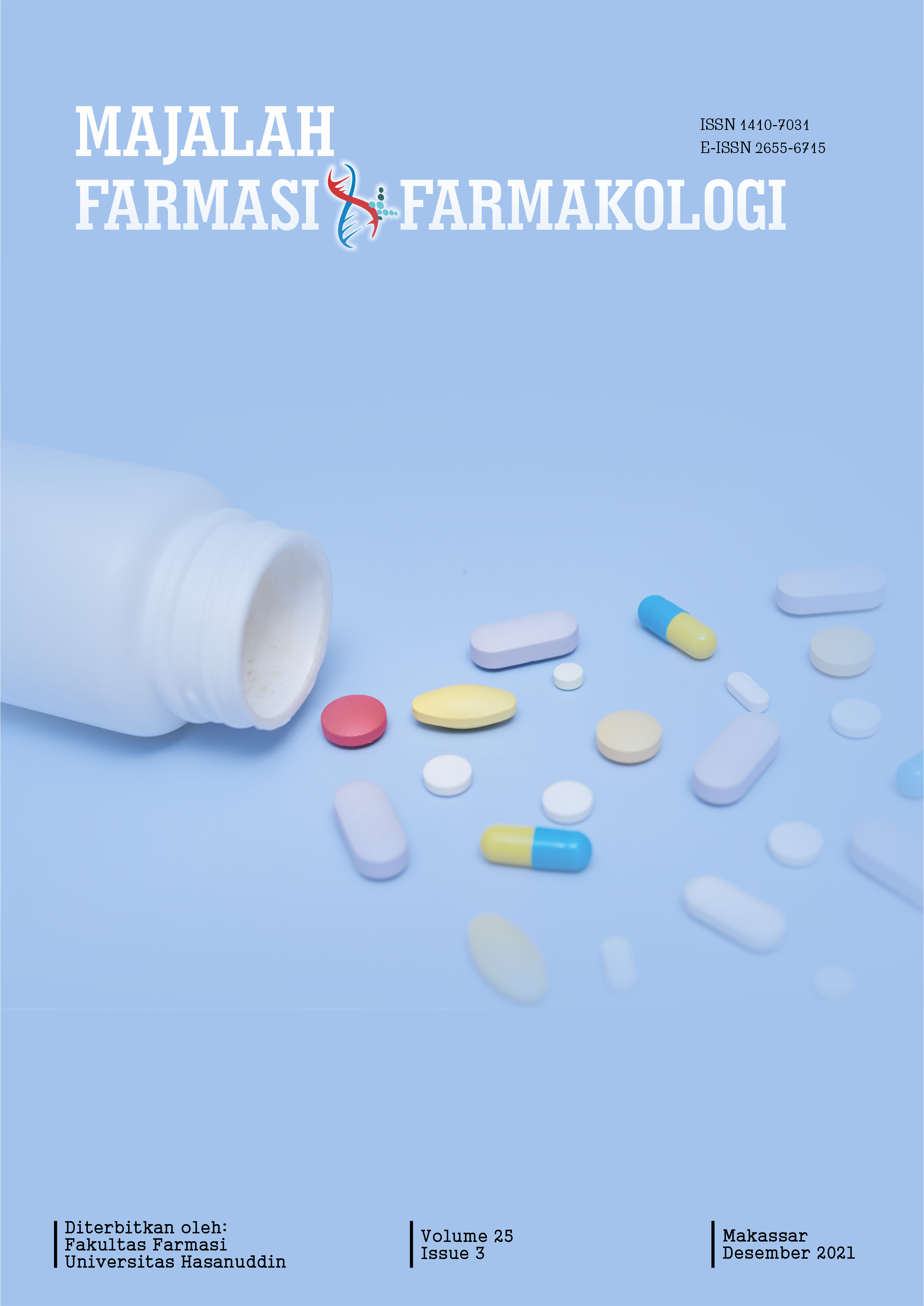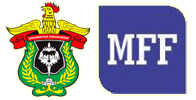FORMULASI DAN UJI AKTIVITAS ANTIBAKTERI GEL EKSTRAK KERING RIMPANG KUNYIT (Curcuma domestica Val.) TERHADAP Propionibacterium acnes
Keywords:
propionibacterium acnes, ektrak kering rimpang kunyit, gel, Propionibacterium acnes, Ekstrak Kering Rimpang Kunyit, GelAbstract
Propionibacterium acnes adalah bakteri utama penyebab timbulnya jerawat. Salah satu bahan alam yang dapat dimanfaatkan sebagai antibakteri adalah ekstrak kering rimpang kunyit (Curcuma domestica Val.) karena memiliki kandungan senyawa kurkumin dan minyak atsiri. Penelitian ini bertujuan untuk mengetahui pengaruh konsentrasi formulasi gel ekstrak kering rimpang kunyit terhadap stabilitas fisik dan aktivitas antibakterinya pada Propionibacterium acnes ATCC 11827 dengan metode sumuran. Ekstrak kering rimpang kunyit diformulasi dalam bentuk gel dengan dua konsentrasi yaitu F1 (35%) dan F2 (45%). Gel adalah sistem semipadat terdiri dari suspensi yang dibuat dari partikel anorganik yang kecil atau molekul organik yang besar, terpenetrasi oleh suatu cairan. Hasil evaluasi selama 8 minggu penyimpanan F1 (35%) memiliki stabilitas fisik yang lebih baik dibandingkan F2 (45%) pada pemeriksaan organoleptik, uji homogenitas, uji pH, uji daya lekat, uji daya sebar, uji iritasi dan uji stabilitas dengan metode sentrifugasi. Hasil uji statistik kruskal wallis terdapat perbedaan yang signifikan (p<0,05) antar formula terhadap diameter zona hambat bakteri, dimana F2 (45%) memberikan diameter hambat yang paling besar yaitu 19,82±0,27 mm dengan kategori daya hambat kuat.
References
Richter C, Trojahn C, Hillmann K, Dobos G, Stroux A, Kottner J, and Peytavi UB. Reduction of inflammatory and noninflammatory lesions with topical tyrothricin 0.1% in the treatment of mild to severe acne papulopustulosa: A randomized controlled clinical trial. Skin Pharmacology and Physiology. 2016; 29(1):1–8
Djuanda, A. Ilmu penyakit kulit dan kelamin.. Edisi 7. Balai Penerbit FKUI. Jakarta; 2016
Wasitaatmadja. Penuntun Kosmetik Medik. Universitas Indonesia. Jakarta; 1997
Dalimartha, S. Atlas Tumbuhan Obat Indonesia. Jilid 3. Puspa Swara. Jakarta; 2007
Muadifah A, Amini HW, Putri AE, dan Latifah N. Aktivitas Gel Antibakteri Ekstrak Rimpang Kunyit (Curcuma domestica Val.) Terhadap Bakteri Staphylococcus aureus. Jurnal Sain Health. 2019; 3(1): 45-54
Departemen Kesehatan Republik Indonesia. Farmakope Indonesia. Edisi V. Departemen Kesehatan Republik Indonesia. Jakarta; 2014
Lachman L, dan Lieberman HA. Teori dan Praktek Farmasi Industri Edisi Kedua, 1091-1098. UI Press. Jakarta; 1994.
Ansel, HC. Pengantar Bentuk Sediaan Farmasi. Edisi 4. Universitas Indonesia. Jakarta; 1998
Depertemen Kesehatan Republik Indonesia. Farmakope Indonesia. Edisi III. Departemen Kesehatan Republik Indonesia. Jakarta; 1979
Departemen Kesehatan Republik Indonesia. Farmakope Indonesia . Edisi IV. Departemen Kesehatan Republik Indonesia. Jakarta; 1995
Setiawan D. Formulasi Serum Gel Anti Jerawat Ekstrak Etanol Kulit Buah Nanas (Ananas comosus L. Merr) Serta Uji Aktivitas Terhadap Bakteri Staphylococcus aureus ATCC 2592. E-Skripsi Universitas Muhammadiyah Pekajangan Pekalongan. 2018; 1-10
Voigt R. Buku Pelajaran Teknologi Farmasi. Edisi 5. Diterjemahkan oleh Soendani Noerono,Gadjah Mada University Press. Yogyakarta; 1994
Depertemen Kesehatan Republik Indonesia. Formularium Indonesia. Depertemen Kesehatan Indonesia. Jakarta; 1985
Suryani N, Mubarika DN, dan Komala I. Pengembangan dan Evaluasi Stabilitas Formulasi Gel yang Mengandung Etil p-metoksisinamat. Pharmaceutical and Biomedical Sciences Journal. 2019; 1(1): 29-36
Ikhsanudin A dan Mardhiyah S. Formulasi dan Uji Antijerawat Gel Ekstrak Etanol 70% Buah Belimbing Wuluh (Averrhoa bilimbi Linn.) terhadap Bakteri Propionibacterium acnes. Fakultas Farmasi Universitas Ahmad Dahlan. 2019; 5(1): 416-426
Martin A, Swarbick J, dan Cammarata A. Farmasi Fisik 2. Edisi III. UI Press. Jakarta; 1993
Tranggono, R.. & Fatma, L. Buku-Pegangan-Ilmu-Pengetahuan-Kosmetik. PT Gramedia Pustaka Utama. Jakarta; 2014
Lachman L, Lieberman AH, dan Kanig JL. Teori dan Praktek Farmasi Industri. UI Press. Jakarta; 2008
Garg AD, Aggarwal S, Garg, and Sigla AK. Spreading of Semisolid Formulation: An Update. Pharmaceutical Tecnology; 2002
Lumentut N, Edy HJ, dan Rumondor EM. Formulasi dan Uji Stabilitas Fisik Sediaan Krim Ekstrak Etanol Kulit Buah Pisang Goroho (Musa acuminafe L.) Konsentrasi 12.5% Sebagai Tabir Surya. Jurnal MIPA. 2020; 9(2): 42-46
Luthfia M, dan Sagala Z. Formulasi Dan Uji Antibakteri Sediaan Obat Kumur Dari Ekstrak Etanol 70% Daun Suji (Dracaena angustifolia (Medik) Roxb) Terhadap Bakteri Streptococcus mutans. Indonesia Natural Research Pharmaceutical Journal. 2018; 3(1): 1-9
Downloads
Published
Issue
Section
License
Copyright (c) 2021 Majalah Farmasi dan Farmakologi

This work is licensed under a Creative Commons Attribution-NonCommercial 4.0 International License.
The copyright to this article is transferred to Universitas Hasanuddin (UNHAS) if and when the article is accepted for publication. The undersigned hereby transfers all rights in and to the paper including without limitation all copyrights to UNHAS. The undersigned hereby represents and warrants that the paper is original and that he/she is the author of the paper, except for material that is clearly identified as to its original source, with permission notices from the copyright owners where required. The undersigned represents that he/she has the power and authority to make and execute this assignment.
We declare that:
- This paper has not been published in the same form elsewhere.
- It will not be submitted anywhere else for publication prior to acceptance/rejection by this Journal.
- A copyright permission is obtained for materials published elsewhere and which require this permission for reproduction.
Furthermore, I/We hereby transfer the unlimited rights of publication of the above-mentioned paper in whole to UNHAS The copyright transfer covers the exclusive right to reproduce and distribute the article, including reprints, translations, photographic reproductions, microform, electronic form (offline, online) or any other reproductions of similar nature.
The corresponding author signs for and accepts responsibility for releasing this material on behalf of any and all co-authors. This agreement is to be signed by at least one of the authors who have obtained the assent of the co-author(s) where applicable. After submission of this agreement signed by the corresponding author, changes of authorship or in the order of the authors listed will not be accepted.


